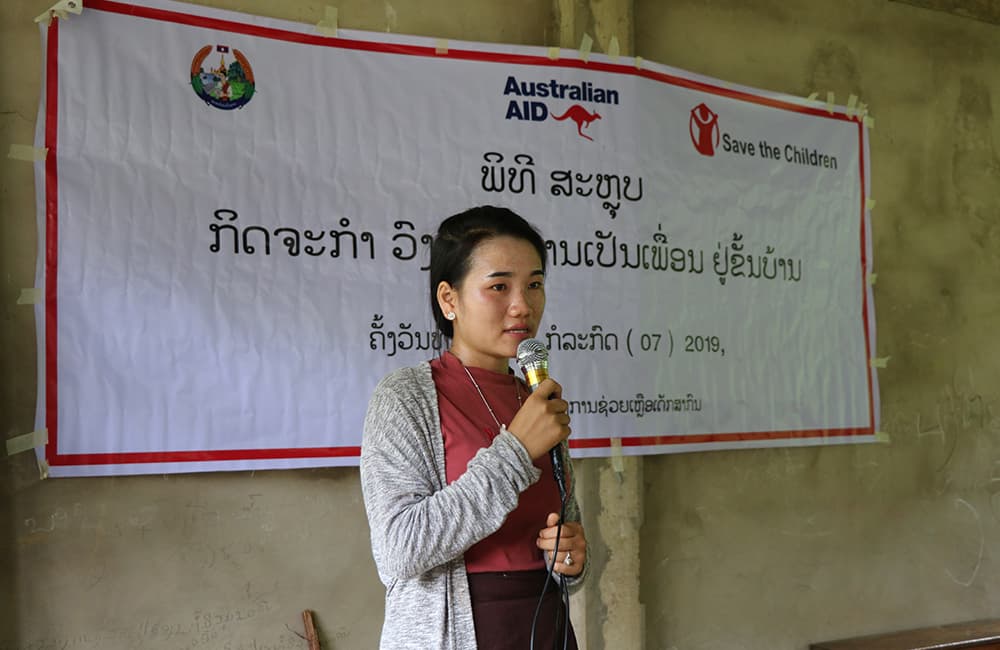Giving girls a chance to dream of a better future
Laos has the highest rate of child marriage in East Asia, with about 20% of girls under 20 married. In some Laotian ethnic groups, including Hmomg and Khmu, child marriage is a cultural norm and it’s expected girls should be married by the age of 17. Coupled with high rates of girls out of school, it’s clear greater support is needed to protect and nurture adolescents to adulthood.
The risks of early marriage are immense. Early marriage forces girls out of education and into a life with fewer opportunities and increased risks of violent abuse.
This harmful practice denies girls their right to make vital decisions about their sexual health and wellbeing. Many become pregnant before their young body is ready, which increases the risk of complications during pregnancy and childbirth. Pregnancy and childbirth complications are the leading cause of death among adolescent girls aged 15-19 years globally.
Safe in my Community
In 2018, Save the Children began the Safe in my Community program across three districts in Laung Prabang. The Safe in my Community program is run by Save the Children in two of those districts thanks to the generosity of our individual supporters and funding from the Australian Government. The program improves the resilience of adolescents (10-14 year olds) and ensures they develop in safe and supportive communities.
Children develop key skills related to avoiding early marriage like negotiation skills, understanding the importance of gender equality and how to seek help when needed.
Phounsy Phasavaeng is Save the Children’s Head of Child Protection and Adolescent Programs in Laos. She says child marriage is a huge issue in many ethnic communities. “In the Mon Khmer group, the percentage of under 18s who are married is about 47%. In the Hmong group it’s as high as 57%.”
The practice of ‘bride theft’ is traditional in Hmong communities, says Phounsy. “It doesn't matter how old you are, girls can be as young as 12 or 13. They can be kidnapped by a man, or sometimes many men at any time of day or night. Once they reach the man’s house, they must marry them. They’re not allowed to return to their parent’s house or be rescued. There’s an acknowledgement that the girl will be married no matter how old the man is, and whether or not he is already married.”
Other harmful practices also abound, says Phounsy. “In the Khmu community, there’s a taboo around men touching women’s clothing or washing women’s clothing. It’s believed to bring bad luck. This means men can’t support their wives even when they are pregnant or giving birth.”
A gender equality transition
One of the project’s initiatives is the Friendship Circles that encourage adolescents to think differently about early marriage and gender equality norms. It’s been enormously successful.
“It’s had a significant impact,” says Phounsy. “They have a better understanding of the negative impacts of early marriage and gender roles and norms. This age is ideal to shift attitudes and behaviour, it’s much harder to educate adults.”
“They have been able to share and learn from each other as well as from mentors in their community. I’ve seen boys start to help with household work like washing dishes and talk to their parents about wanting to get their sisters educated too. Girls are communicating more with parents on delaying marriage and are able to identify the benefits of delayed marriage.”
The Friendship Circles are complemented by Parent and Caregiver Groups that raise awareness of the effects of harmful practices and promote gender equitable parenting.
The story of Yia Thor
Yia Thor was 17 when she was married. She’d come from a large Hmong farming family of 10, and stopped school after 7th grade. Violence was common in her marriage, she says. “In the past I sometime accepted the violence in the house just to keep the family together. Now I know that violence is not acceptable and we need to talk, understand and respect each other if we want to be happy.”

Yia Thor is a Safe in my Community mentor in Luang Prabang, Laos.
Photo: Save the Children.
She divorced her husband two years later. And she’s now a mentor for the adolescents in her community as part of the Safe in my Community program.
“In the past I did not think about the negative consequences of early marriage, I did not know about it. But now I can share my story, which is similar to the stories of the curriculum, and I can inform girls who are younger than me on the risks associated to early marriage.”
Becoming a mentor has improved not just the lives of girls in her community, but also given her self-confidence and esteem. “I feel I have changed a lot since I have had the opportunity to be a mentor. I am really proud of the role I am playing in my community. I am now more able to communicate with children and adults and I have learnt a lot about gender, negotiation and communication. All these skills can bring peace in the families and children now know where to ask for help. I have been scared of asking for help in the past, but now I feel confident to talk to people and I can protect myself and others, especially children. Now I know I can be important for them.”
Save the Children’s Safe in my Community Project is supported by the Australian Government through the Australian NGO Cooperation Program (ANCP).